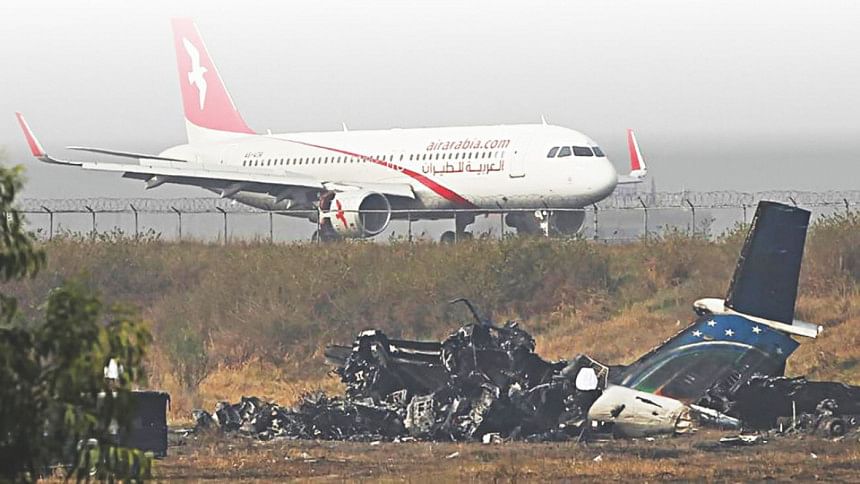US-BANGLA AIR CRASH: A tort law perspective

The recent tragic air crash of the US-Bangla Flight BS211 in Kathmandu, which killed more than 50 passengers and injured around 20 others, is rife with potential liabilities in tort law. This incident can, hence, serve as yet another reminder about the burning necessity of having an effective legal framework for tort and the opportunity cost of not having one. Indeed the tortious implications of the US-Bangla air crash was recognised by Madam Justice Naima Haider in her recent lecture titled 'Development of Tort Law Regime in Bangladesh' hosted by Lex Oration on March 16, 2018.
A claim in tort law, as opposed to criminal law, is an action for recovery of damages (i.e. monetary compensation) which seeks to compensate the harms suffered by a person as a result of an intentional or unintentional act of another person, rather than putting the wrongdoer in prison. The person claiming the damages (i.e. the claimant) can be a primary or secondary victim. In the case of the US-Bangla air crash, the 20 or so passengers who survived the accident but suffered injuries, as primary victims, can file a tort claim for pain and suffering, medical bills and loss of past and future wages. As for other passengers and crew members who died in the accident, their next of kin are secondary victims whose cause of action in tort is for wrongful death, which is filed in situations where a loved one died as a result of negligence. They can specifically sue for loss of support and income (e.g. if the deceased was the primary breadwinner of the family), emotional distress and funeral expenses, etc.
While the circumstances of aviation accidents vary from case to case, generally claims for personal injury or death resulting from an aviation accident pertain to the tortious doctrines of negligence and product liability, or an amalgamation of the two. However since product liability would pertain to the manufacturer of the airplane i.e. Bombardier Inc, a Canadian company who is therefore outside the jurisdiction of Bangladesh, the doctrine of negligence is more pertinent to our discussion.
Negligence is the legal term denoting the failure to do (or not do) something that a 'reasonable person' would have done under the same circumstances, which has been construed to protect others from foreseeable risks of harm. Pilots, airline companies and air traffic controllers are among those subject to negligence claims when an aviation accident occurs. Negligence claims are usually brought when human errors (such as a mistake by the pilot or misdirection by the air traffic controller) cause a crash. The plaintiff will have to satisfy the reasonable person test, prove that the defendant did not act as a reasonable person in the same circumstances would have acted. For example, if the defendant is the pilot the plaintiff can try to show that a reasonable pilot would not have made an error (e.g. failure to adhere to instructions) that caused the crash.
Alternatively, if the defendant is the airline company, i.e. US-Bangla Airlines, then their negligence has to be proved by showing their actions or inactions fell below the required industry standard. For instance, this would be the case if US-Bangla failed to provide the pilot sufficient training to land in Kathmandu airport (which due to its unique, hilly terrain, requires specific training) to save costs and therefore maximise profits. If such direct carelessness or recklessness can be proven, then US-Bangla will be held liable for the harms suffered by not only the passengers, but also the cabin crew members including the pilot (who can sue through specific negligence liability regime known as employer's liability), including any relevant secondary victims.
However, even if US-Bangla can show that it had fulfilled its obligations (by carrying out its duty as required), it may still be liable to pay damages through the doctrine of vicarious liability of an employer, if the pilot (i.e. their employee) can be shown to have been negligent. This is a non-fault based liability, which allows claimants to recover damages from the person or entity in the best financial position to pay the compensation, which is usually the employer rather than an individual employee.
Claimants may have a cause of action under a colonial era statute named Fatal Accidents Act 1855, which has successfully been used in the past by secondary victims of road accidents to impose vicarious liability on a company for the reckless driving of its employee in the recent case of Bangladesh Beverage v Rowsan Aktar and Others (69 DLR 129), where 1.7 crore was awarded as compensation by the Appellate Division. However, this Act has never previously been used in the context of an aviation accident, but arguably the wording of the Act is wide enough to cover air crashes as a 'fatal accident'. Alternatively, the claimants may also file a class action suit akin to the MV Nasreen launch capsize case filed by Bangladesh Legal Aid and Services Trust (BLAST) against Bangladesh Inland Water Transport Authority (BIWTA), where the High Court Division, in July 2017, ordered BIWTA to pay damages amounting to Taka 17 cores and 11 lakhs to both primary and secondary victims of the accident.
While tort law is not nearly as enforceable in Bangladesh as it ought to be, the aforementioned cases illustrate that the victims of the US-Bangla air crash do have important legal precedents they can utilise to try and avail the compensation they may rightfully deserve. In so doing, they may ultimately help set another crucial legal precedent which would take the implementation of tort law a step further in the country.
The writer is Researcher, Bangladesh Institute of Law and International Affairs (BILIA).

 For all latest news, follow The Daily Star's Google News channel.
For all latest news, follow The Daily Star's Google News channel. 





Comments